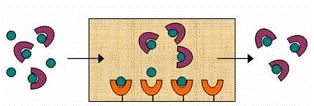Department of Chemistry
Document Type
Article
Date of this Version
8-5-2010
Citation
Published in final edited form as: Clin Chim Acta. 2010 August 5; 411(15-16): 1102–1110. doi:10.1016/j.cca.2010.04.007. Version presented here is from NIH PubMed Central.
Abstract
Background—One of the long term complications of diabetes is the non-enzymatic addition of glucose to proteins in blood, such as human serum albumin (HSA), which leads to the formation of an Amadori product and advanced glycation end products (AGEs). This study uses 16O/18O-labeling and matrix-assisted laser desorption/ionization time-of-flight mass spectrometry (MALDI-TOF MS) to provide quantitative data on the extent of modification that occurs in the presence of glucose at various regions in the structure of minimally glycated HSA.
Methods—Normal HSA, with no significant levels of glycation, was digested by various proteolytic enzymes in the presence of water, while a similar sample containing in vitro glycated HSA was digested in 18O-enriched water. These samples were then mixed and the 16O/18O ratios were measured for peptides in each digest. The values obtained for the 16O/18O ratios of the detected peptides for the mixed sample were used to determine the degree of modification that occurred in various regions of glycated HSA.
Results—Peptides containing arginines 114, 81, or 218 and lysines 413, 432, 159, 212, or 323 were found to have 16O/18O ratios greater than a cut off value of 2.0 (i.e., a cut off value based on results noted when using only normal HSA as a reference). A qualitative comparison of the 16O- and 18Olabeled digests indicated that lysines 525 and 439 also had significant degrees of modification. The modifications that occurred at these sites were variations of fructosyl-lysine and AGEs which included 1-alkyl-2-formyl-3,4-glycoyl-pyrole, and pyrraline.
Conclusions—Peptides containing arginine 218 and lysines 212, 413, 432, and 439 contained high levels of modification and are also present near the major drug binding sites on HSA. This result is clinically relevant because it suggests the glycation of HSA may alter its ability to bind various drugs and small solutes in blood.



Comments
Copyright Elsevier Inc. Used By Permission.